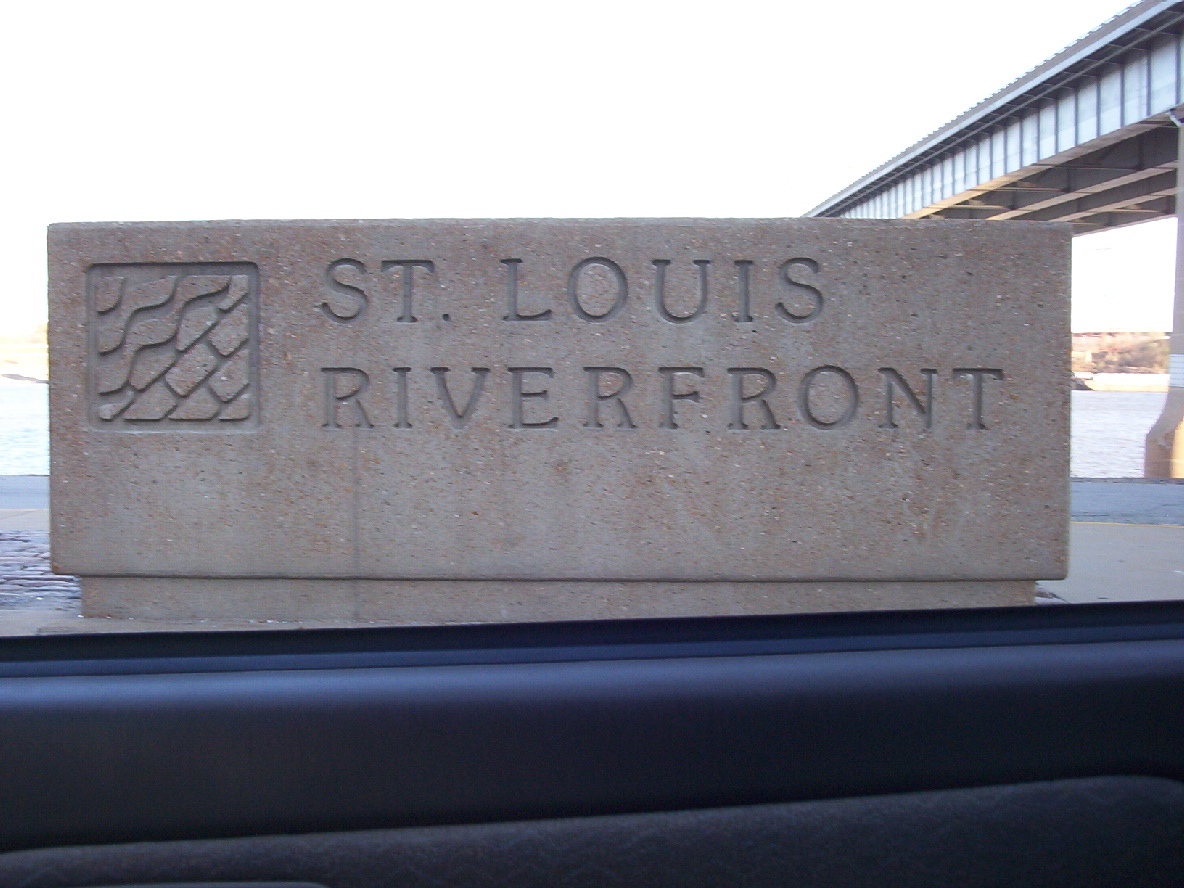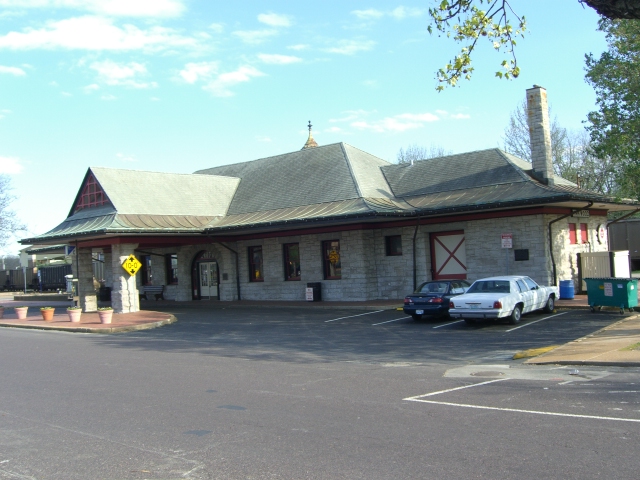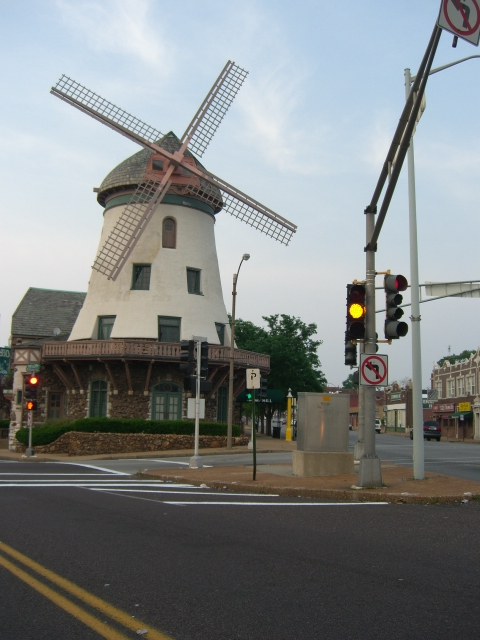Spot surveys were the norm in the St Louis area for many years. They were cheaper. The title coverage was not quite as great, but it wasn’t significantly different, so why bother paying for a boundary survey which would be at least a $100 more? Now the primary title companies in the area are insisting on boundary surveys before providing survey coverage to the buyers. Yesterday I got the results back on a villa in a very nice area. We had 6 encroachments that the seller is now going to have to pay to have fixed. That’s $30 a pop for each of the six encroachments just to record the paperwork with the county. That’s time and trouble to go to each of the neighbors AND the villa’s trustees and management company to get them to sign off and approve easements for the encroachments AND if the people who are being encroached upon don’t agree, then a lot of money is going to have to be paid to move the entire perimeter fence for the villa. That’s the potential of having to pay the title company $150 (approximately) to draft an easement deed for each encroachment – luckily the title company we are dealing with no longer charges that fee, but many still do. Why are we making the seller do the work now? I represent the buyer – the rules and regs for the complex clearly state that the owner can be fined if their fence is on someone else’s property AND when the property next door is sold, the new buyers can make the fence be moved at that time, which would then be at my buyer’s expense. I’m not protecting my buyer if I take the attitude that everyone is OK with the situation now, since we then run the risk that the full cost would be against my buyer at a later time. The cost to the seller now – FAR more than the cost of a boundary survey originally when he could have had the person he bought from fix the problems and pay the costs that he will now pay. – A penny saved – a pound foolish. Always make sure that the survey’s are checked – it’s a good idea also to take the survey and go back to the home and look at the lot with the survey in hand. I have one now where the surveyor put in writing that there were no visible encroachments but I can stand in the street, look at the stakes and pins and see what appears to be an encroachment, so I’ve got a call into that surveyor to ask why that isn’t an encroachment.
Wrinkles and Warts – our houses get them also

The husband had switched out some electrical outlets and light switches over the years. The home has aluminum wiring. He apparently went to the hardware store and picked up switches and outlets without making sure that they were CO/ALR and could be used with aluminum wiring – $8000 bid just to check every outlet and switch in the home to see which ones were done correctly and which ones were done incorrectly BEFORE the electrician fixed the ones that were done incorrectly, not to mention the fire hazard they has been living with all these years.
The children are grown and gone so they seldom went to the basement – as a result they hadn’t noticed that the plumbing stack had reached the point where it was leaking.
The gas furnace had 3 leaks and the flu liner was so corroded that it was leaking – the gas leaks you couldn’t see, but the flu liner corrosion could be seen. Add the gas leaks in the house to the electrical problem caused by the wrong switches and outlets and you have a much larger problem.
Codes change over the years, and the codes that the home met when they bought it, aren’t the codes that the home needed to meet now – from GFCI’s that had to be installed to shut-off valves on gas appliances. The list just kept growing, the seller just kept getting angrier and blaming the buyer for being picky about wanting things taken care of that hadn’t been a problem until the buyer came along.
The buyers, who had taken care of their home and had fixed it up before selling it, kept their cool, and were exceptionally good at recognizing what were important items and what were annoyances. But it should never have happened. The sellers had been living in an unsafe environment for some time without realizing it. If they hadn’t put their home on the market, which generated home inspections, they could have had disastrous consequences from several of the problems that were found.
It’s HARD, to look at your home with an inspector’s eye. But periodically you need to.
1) If you live in a community that has a municipal inspection (from your city or county or both), you can get a copy of the inspection checklist and go through it on your own or with a handyman to find out the areas where your home might have issues (I don’t recommend asking the municipal inspector to come, because if your home has issues they can force you to move out while the issues are being fixed and most people don’t want to do that). Then fix them.
2) Some heating and cooling companies will come check your system out for you for a minor charge at the beginning of each season, but you need to ask if they will check your gas lines and your flues when they do the inspection, not just the furnace and air conditioner. They are the people who repair them, so they can check them, but they won’t automatically do it in their seasonal inspections unless you ask for it.
3) Look at your plumbing stacks – in a newer home they will be PVC plastic pipes and you don’t have to worry about them, but in an older home they are cast iron and they will rust through from the inside out. Look for brown stains – look for “growths” – they are called carbuncles. They are actually boils where the cast iron is rotting from the inside out and when it rots enough, the sewerage will leak out through the hole. Do not cut off the rust and paint over it, it will come back with a vengeance. At that point, your stack has to be replaced – call a plumber. Make sure you look at the section of the stack that is at the top of the floor joist/at the basement ceiling (ie look up) not just the section of the stack that is the straight pole in your basement.
4) Check your electrical panel box. Go to a website called “Is My Panel Safe?” if your panel is listed here, consider getting a new one.
If you have any questions, please consider contacting a local realtor to get the name of a reputable building inspector to help you (in the State of Missouri, building inspectors are not licensed and ANYONE, can be a building inspector without any training or experience. As a result, your local Realtor will have a list of inspectors that they know are experienced, do a good job, and will provide you with the information that you can use to help you to have a safe home for your family.
As always, if you would like more information, please go to my website at DaleWeir.net, Dale
Taking care of Vacant Homes

Both as a friend and as a Realtor, I sometimes end up taking care of vacant homes for people. Often I get asked for my “checklist” of what to look for and how to take care of a home. When someone is asked to care for a home, it’s often a simple, “will you watch over my home for me” with no real guidance or instructions, and while that works for a short vacation trip, it doesn’t work when the homeowner is gone for a much longer time period. As a result, I’ve written out these instructions to help the many people who ask me for help.
One thing I would suggest is up front, determine how the person taking care of the home is going to be reimbursed for any out-of-pocket expenses. There will be some things that regardless of how much “stuff” the homeowner leaves behind, he won’t have left enough or the right things and the person caring for the home will have to go buy – whether it’s light bulbs or insect spray or leaf bags. Does the homeowner leave $100 with the person taking care of the home and then send more money as needed? Does the person caring for the home keep receipts and then settle up at a set time? It’s up to you, but it needs to be decided in advance.
When it comes to caring for a vacant home, there are differences based on location – the issues you will face in a southern climate are different then those you will face in a northern climate, but there are some very basic starting points. First is to define why you are taking care of it. Watching a home for someone who is away on vacation is different than watching a home for someone who is deployed in the military for an extended time period and will be coming back to their own home in several months, or even a year or two later. You want to make sure that the home isn’t ticketed by the local municipality for not having mowed the yard, that it doesn’t get damaged from a storm or a sewer backup that no one catches until it’s a big problem or you definitely want t make sure the home isn’t marked as “empty” by thieves. All of which are totally different than keeping a home in a show-ready state when it’s on the market to be sold. As you go through my list, please keep that in mind.
Take care of the exterior – make sure the yard is watered and mowed and weeds trimmed (and that included not just flower beds but the cracks between the sidewalks and driveways). Keep vines under control as they can grow up and force their way into a home through windows and cracks. In the fall, rake the leaves. In the winter, at the minimum if the home is not being shown, open the garage door and drive a car through the snow from the street to the garage and out to make it look like the home is being used and shovel the walk. If the home is for sale, then shovel the drive and the walks (this helps to prevent a buyer from slipping and falling on the snow as well). If you have an exterior storm drain close to a door (in St Louis, we have a tendency to have them close to exterior basement doors), keep them clear of leaves and debris – if they get covered and the rain water can’t go down the drain, it will go back into the home. Keep downed branches and brush picked up and take out any dead bushes.
Pick up the free newspapers, phonebooks and marketing materials that are left on the doorstep and on the door handles and in the mailbox. Even when the mail is stopped, you will periodically have a temporary mailperson assigned to the route who will deliver the junk mail without paying attention to the fact that it is an empty house, so check the mailbox periodically.
When the seasons change and it gets cold, make sure that hoses are disconnected and taken inside, and that outside faucets are turned off from inside the home if at all possible. If there is a sprinkler system, disconnect it and take off the multi-hose connections at the faucets. Sometimes I invest a little bit of money (a couple of dollars) in putting the Styrofoam covers over outside faucets if I can’t find the inside faucet shutoffs. Make sure that all water is allowed to run out of sprinkler hoses and the end caps are taken off as well. If you are in an area where children may turn on the faucets to play with the water or neighbors may help themselves to watering the yard or washing the car with your water, you may want to disconnect the outside faucets (just put a note in your files so you remember that they are shut off or put a note at the shut off valves inside the home) If a home is really vacant and no one is going to be there, then the utilities may be turned off and the water shut off and antifreeze put in the system (toilets and water heater will be drained then) but a sign goes up warning people or someone WILL use the toilet and then it is a mess (in which case you have to carry bottles of water to the home and manually flush it)
After any large storm, someone should walk around the outside of the home and check it for damage and walk around the inside of the home and check for broken windows, damaged roof, leaks, water coming UP drains, etc. Any damages should be taken care of right away. If a hurricane is coming, put up the shutters and boards.
Bugs are a way of life, but spiders will take over a vacant home in a heart beat. Spray the interior and the exterior periodically, especially around exterior lights, exterior doors and windows – inside and outside. Take a stick and knock down the cobwebs even if it is close to Halloween, you don’t want spider eggs hatching and the more webs you have, the more neglected the home looks. In some areas, you may want to put out mouse traps, bug glue traps (both those that go on the floor and those that hang down from the ceiling) and cockroach motels.
Water – Run water down the sinks and tubs/showers periodically to prevent the pipes from getting dry enough that sewer gases come back up (I do it at least once a month). Flush the toilets periodically – water will evaporate from the toilets leaving nasty rings – MAKE SURE when you flush that you stay around long enough to make sure that they stop flushing since the seals can dry up, chains can get hooked up, etc and the water can continue to run indefinitely with no one in the house to catch it (again at least once a month). Gaskets dry out. Both laundry and dishwashers need to be run every few months to ensure that the gaskets and hoses don’t dry out too much or they will leak when they are run. Also the garbage disposal should be cleaned before the home owner leaves or accumulated soap, food particles, etc can essentially gum it up to the point that it will freeze and become inoperable.
My parents once had the water supply line to the ice maker for their refrigerator go haywire while they were out of town on a long trip. They came back to find their entire house flooded. After that they turned the water off to their home whenever they left town for more than a day or two and they would have to turn it back on when they got home again before they could get a glass of water, for many that would be overkill, but after having the water flood their kitchen, and then be absorbed by the carpet in the dining room, family room and living room and then seep into the basement and flood the basement and have to deal with the mold and mildew for years (and the collateral damage of not only the floors and walls that were ruined but cleaning and reupholstering the furniture, paintings were ruined , boxes of things stored in the basement were ruined, etc) they took no chances.
Electricity – If the utilities are on, the home owner may want to invest in motion detector lights or lights on timers that will come on periodically to give an illusion that the home is occupied. You may want to unplug the garage door opener. And turn off all the big appliances at the breaker box (just put a note that they are turned off). If there are outside electrical outlets, and the home is in an area where someone might “help themselves” by using the home’s electricity, shut them off at the circuit breaker box.
Likewise, if possible shut off any outside phone jacks so no one runs up a phone bill.
Periodically check the thermostat – if it’s newer and has a battery, make sure the battery doesn’t go out, in which case the thermostat won’t work. When the seasons change, someone has to reset from one season to the next – turn off the a/c and turn on the furnace, turn on and off humidifiers, etc. In a hot, humid climate, the a/c may be left on just to keep the moisture down in the house to keep the mold and mildew from growing
Water heaters can be turned to vacation settings to keep utility bills lower.
Any refrigerators left in the home can be turned to their lowest setting (freezer and refrig)
Light bulbs and toilet paper and some hand soap (and if you’re really nice some paper towels or a small hand towel) should be in the homes as people looking at the homes (and those taking care of the home) do need to use the facilities). (I have small garbage cans under the bathroom sinks and kitchen sink (or plastic garbage sacks) that I periodically take home and empty (empty homes don’t have trash pickup).
If a home is being shown for sale, someone needs to check on the “nice cleaning”. Sometimes it’s a matter of dusting as well, or cleaning the windows (inside may stay clean but outside won’t). Periodically the floors need to be swept if people have tracked in leaves etc (you can ask the agent for shoe covers if the floors are carpeted to keep the carpets clean).
If there is a pool or hot tub, it may need to have the chemical balance checked periodically, so instructions and chemicals may need to be left by the homeowner.
Check the refrigerator, they do go out while they are running. If you stop using the refrig, make sure to unplug it and block the door open so you get enough air circulation inside so it does not develop mold and mildew inside.
Believe it or not, things that aren’t being used break. I walk through a home and look for “odd” things – is there a leak that has developed somewhere, is there a doorknob that is loose, is there a window that isn’t closed properly or that has cracked from a tree branch hitting it in a storm, a door that isn’t locking easily – I look for security issues as well as preventative maintenance as well as things that make a home look nice. I also try to keep air fresheners in the home and if the home has ceiling fans I’ll keep them on low so the air continues to circulate regardless of temp, to keep the house from smelling stale. Herbal tea bags can help keep drawers and cabinets smelling nice.
I sincerely hope that this helps you as you care for a vacant home. If I’ve missed anything, please let me know. I’m always looking to improve this list.
VA Loans Provide Extra Security

The Veterans Administration had provided some extra help for Veterans and military members who may be having problems with their mortgages. The first thing a veteran or military member should do is contact the VA at 877-827-3702 or http://www.homeloans.va.gov/ and talk with a counselor.
Their options include:
The Servicemembers Civil Relief Act – to qualify for this program, the military member has to have gotten the mortgage prior to the current period of active duty service. The program can provide a lower interest rate for up to ONE year and can provide forbearance, or prevent foreclosure or eviction up to 9 months from the period of military service
If the military member or Veteran has a VA Loan, it is VERY important to remember that the VA guarantees the loan. If the member defaults, they will lose their VA loan eligibility up to the amount that the bank loses and the VA covers, but the bank CAN NOT go back against them if they accept the VA payout!! The VA WILL work with the veteran or military member and the bank to explore all options first, before the home is foreclosed on – Call 877-827-3702 for help.
If the military member or Veteran has a NON-VA loan, (ie a conventional, FHA or sub-prime loan) the VA can offer guidance and advice, but they cannot legally intercede on the veteran’s behalf.
The Veteran or military member CAN however, refinance their loan to a VA loan as a result of the Veterans Benefits Improvement Act of 2008 which was signed into law on Oct 10, 2008. Veterans can refinance up to 100% of the value of the property now (previously they could only refinance up to 90%).
Driving in St Louis for Newcomers

Here’s a tongue in cheek look at driving in St Louis. When you’re ready to start looking at homes, give me a call, I know my way around and will be there to help you find the right home in the right area!
A VISITOR’S GUIDE TO DRIVING IN ST. LOUIS, MISSOURI:
The morning rush hour is from 6:00 to 10:00 am. The evening rush hour is from 3:00 to 7:00 PM. Friday’s rush hour starts Thursday morning.
Gravois Road can only be pronounced by a native. Ditto for Spoede and Chouteau.
Construction on Highways 40, 64, 70, 255, 270, 44, 55 and I-170 is a way of life, and a permanent form of entertainment. The current construction will end in time for us to start renovating the next highway on our list however.
Most St Louisans know enough short cuts through the metro area that they can get anywhere they want without getting on a highway and they can often get there faster.
The Page Avenue extension and Airport expansion projects took over 20 years to get approved and St Louisan’s lost track of how many political figures claimed them as their own ideas.
A St. Louisan from South County has never been to North County and visa versa.
West County has everything delivered. If you live in St Charles County you will only come to St Louis County for school field trips, the zoo, ballgames (baseball and/or football) or an occasional concert unless you have out of town guests.
St Louisan’s were aghast when the federal government required them to redo the highway signs to indicate that the federal highway went to cities in other states instead of local municipalities.
If someone actually has their turn signal on, it is probably a factory defect, or has been on for the last 17 miles.
There are 2 exits on Highway 40 for Clayton Road and 2 for Big Bend.
All old ladies with blue hair in Cadillacs (driving on Olive west of 270) have the right of way.
Laclede Station Road mysteriously changes names as you cross intersections. As do McCausland, Lindbergh, Watson, Reavis Barracks, Fee Fee, McKnight, Airport Road, Midland, Olive and Clarkson.
Drivers are starting to cut their OWN plates rather than go through the Mo. Vehicle Dept. to get new tags. You can purchase tags from dealers behind QuiK Shops in the city. They are cheaper, the clerks are nicer, and the service is faster.
You can go all four directions on Highway 270: North and South in West County, East and West in South County, and East and West in North County. Confused? So are the St. Louis drivers.
There are 54 school districts on the Missouri side alone – each of which has their own school bus system and scheduled times to block traffic.
There are 75 “official neighborhoods” in the City of St Louis. St. Louisans commonly give directions (especially for restaurants) to strangers based on these neighborhoods which aren’t marked on any maps that are handed out by the tourist board, the AAA or Waze.
There are 91 official municipalities in St Louis County. Each municipality has it’s own rules, regulations, and often their own police departments. More importantly, most have their own snow removal contracts so it’s not uncommon to drive down a road in winter and have one block plowed, the next salted, the next piled with snow and the last partially cleared by residents wanting to get out of their driveways.
No native St. Louisan knows that Lindbergh runs from South County to North County. And, if you tell them, they will not believe you.
Lindbergh belongs to every neighborhood except Kirkwood, who had the nerve to creatively change the name to “Kirkwood Road”.
Highway 270 is our daily version of the NASCAR circuit.
YIELD signs are for decoration only. No native St. Louisan will ever grasp the concept.
Lambert Field and St Louis International Airport really are the same place. The East Terminal however is a different place.
Never ever try to cross a bridge in St Louis during rush hour unless you have a port-a-potty in the car.
The outer belt is Highway 270 which turns into Highway 255 in South County. The inner belt is Highway 170 and if it’s a 3XX number it’s an outer outer belt.
Highway 40 is the same as Interstate 64 through the middle of St Louis.
If you need directions to O’Fallon, make sure to specify Illinois or Missouri.
The City of Ballwin actually proposed once that drivers use connecting strip mall parking lots to get from place to place rather than drive on Manchester Road to cut the traffic on Manchester.
St Louisans are very proud of our city and our highways and byways. We proudly show off the flowers along the side of our highways in the spring (a special project of a former mayor), our bridges (those that have traffic on them and those we walk across and hold concerts on) and we will point out to you that the US highway system started here in St Louis and as far as we are concerned we “Own” Route 66. (as we direct you to Ted Drewes for some Frozen Yogurt)
Remember, if you need help finding your way around when you first get to St Louis and start house hunting, give me a call. I’ll demystify our road system for you!
Whose Minding the Empty Homes

All over the US there are empty houses at the moment. Some are foreclosure and pre-foreclosure homes, some are empty because the homeowners relocated for a new job and haven’t been able to sell. Who’s taking care of them? Some things you can just turn off and leave, but other things need to be maintained and checked periodically. I went to preview one home the other day where the grass and weeds were taller than I am (I’m 5’1″ tall). I’ve gone into homes where the basements were so full of spider webs that I walked out feeling like I needed to go spray myself with insecticide and hope my hair wasn’t full of spiders. I’ve seen some where the bathroom pipes had burst and 2 rooms were flooded. One had broken glass throughout the home. Another had a tree branch sticking through the garage wall and the garage roof was covered with huge tree limbs from a storm. I’ve gone into homes that have doors left unlocked by a previous showing agent and have sat that way no one knows how long. The list goes on and on. All lovely homes, all on the market, but being neglected. The listing agents hadn’t been by to check them out in a very long time and the home owners weren’t in the local area.
If the property is Bank owned, the bank may not actually send anyone to visit the property for several weeks after the foreclosure. The people who come then are basically changing the locks and securing the property. They aren’t there to deal with stuff left behind (especially when its pets that were abandoned). In some cases, but not always, the bank will send a contractor to clean out abandoned property. They will typically shut off the utilities and winterize the plumbing (ie shut off the water to the house, drain water out of the pupes and water heater, then put antifreeze in the system to prevent frozen pipes). Then they will have a contractor periodically check the house. If you are lucky, they come quarterly. If you are unlucky, they come 2x a year or less. A lot can go wrong in a house in 6 months.
If the property is owned by a person, they are still responsible for its upkeep, even if they are no longer living there.
Grass needs to be mowed, weeds & vines pulled in flower beds, light bulbs need to be replaced, batteries in thermostats and smoke detectors need to be changed, furnace filters need to be changed. When the temperature changes, someone has to reset the thermostat and change it from heat to cool or cool to heat or you can destroy the system. If water isn’t run through the drains periodically, sewer gasses can build up and back into the house. The water in the toilet bowls will evaporate leaving nasty rings unless someone periodically flushes the toilet. Gaskets will dry out on the dishwasher if it’s not run once in awhile. The spiders and other insects will take over quickly if no one is there to spray and maintain control. Checking for backed up floor drains, water seeping into basements, ceiling leaks, storm damage – who’s doing it? In winter, who is checking for burst pipes? Did a mouse get in? Or a bigger creature? Has anyone broken into the home or left it unsecured? The list goes on and on.
If the homeowner is lucky, a good neighbor, friend or relative is stopping in and checking on the home, but if the home is empty for long, that gets old and the neighbor, friend or relative gets busy with their own life and slowly doesn’t come around as often. After a storm, the empty house doesn’t have the priority of their own home. There’s no checklist for them to work off of, so it’s kind of hit and miss what they think to do or not do. They don’t carry things in their car with them when they come over, so they try to remember the next time they come over what it was that they meant to bring, but often it gets forgotten.
The person who ends up taking care of it, is often the Realtor. They don’t get paid for checking on the home, property management is not in most of their job descriptions, it’s the home owner’s responsibility to have someone take care of the home. But in most areas, there is no “company” to hire to stop in and check on a home, and where there are, they are expensive enough that they are only used for very expensive homes or for rentals. The Realtors have enough to do without adding that to their job description, but they know that if they want to get the home sold, they need to make sure that the vacant homes get checked periodically and if something is wrong they let the owner know and arrange to have someone come fix it, because if not taken care of the small problem may become a big problem before it’s dealt with and at that point it will cost the home owner most money and could end up costing a sale. Sometimes the Realtors will discuss with the owners in advance having a handyman on call for minor repairs that come up, or having $XX on hand to buy furnace filters, lightbulbs, etc with, but often the Realtors just take care of it. Some bill their clients at the end, some just eat the cost, some call their clients and get permission first and have their clients reimburse them right away, but it’s still their time, their energy and their effort that keeps it going even if the light bulb got paid for.
But as Realtors we have a responsibility also, to let the listing agent know if there is something wrong when we visit a property. I checked on one of mine recently and the doorknob to the basement was off. Since there had only been a couple showings since I had last been to the house, it was fairly easy to find out who was responsible, but it was irritating to have the other agent tell me the door knob had been “loose” when I know if wasn’t. Someone had tried to force the door open using the doorknob without unlocking the upper lock on the door first – it’s the only way it could have happened. How much simpler it would have been to have called me right away and told me, and let me know so I could have had the neighbor come over and fix it that day rather than my finding it a few days later and then having to call the owner and ask if he knew anything about and track down the neighbor and ask him then track down the Realtors who had shown to talk to them. All it took to fix it was a screwdriver.
Fall Tips for Taking Care of Your Home

It’s time for a few fall musings as I look out over the falling leaves, just a week ago they were such glorious color filling the sky – one of the loveliest falls I can remember. Now they lay trodden on the ground. Tomorrow to be sucked up by the municipal vaucumns or in compost piles or picked up by the trashmen. Our lives move on, just as the leaves do, and we prepare for the winter to come. here are a few reminders of things to take care of as we move into the winter months. Best to do when the weather is still this wonderful mild temperature and the days once more are dry.
Picking up leaves? Many of the municipalities will pick them up if you rake them to the curb, in others you will need to bag them for the trash pickup. My husband and I prefer to put ours in a compost pile, turn them in a year and then put them on the garden beds. Don’t forget to check the gutters and clear them and get any leaves that you can off the roofs and out of the areas where they will rot and cause issues with people slipping.
With all the rain, don’t forget to pick up the fallen brush in the yard. During the winter it can be used as tinder for your fireplace, but a brush pile makes a wonderful shelter for birds and small woodland creatures, then in the spring when the municipal brush pickups are scheduled set it out for pickup rather than now.
It’s time to check your furnace and make sure it’s ready for the winter months, if you haven’t done so already. Change the filter, check the humidifier, reset the thermostat from cool to heat, change the batteries in the smoke detectors, make sure that the furnace has space around it to pull air from.
Don’t forget to disconnect your hoses once you have finished cleaning up everything for the winter. Stretch them out & leave them in the sun to get the kinks out, then roll them up and put them away. If you have “extensions” on your faucets take them off as well. Then turn off the outside faucets from inside your home to help prevent freezing problems when winter really sets in.
Your gas furnace & water heater may not be getting enough air. You can add air to the room by putting in a louvered door, or by adding vents in the wall between that room & the rooms next to it. Typically it only takes 2 large return air duct size vents to be cut in the wall then having a return air duct cover put on them to vent the room into the next room& provide adequate oxygen to the gas equipment.
Clean your bird feeders, bird baths and bird houses. Don’t have any? I made a very simple bird bath out of the tray that went under one of my plants, put a few large rocks in it for the birds to sit on and set it out. In the winter I put a small warmer in it to keep the water from freezing. I use the WildBird Store at Manchester and Baxter in the Lafayette Center for all my birding needs. Doyle and Rebecca have a wonderful supply and are always there to answer my questions about the birds. Make sure to keep your seed in a dry place that is safe from marauding squirrels and other creatures (I have raccoons) – I use a metal garbage can with bricks on the lid.
Now while the ground is wet it is easier to pull the last of those weeds that you don’t want to come back in the fall. These need to really go away, not go in the compost pile if you don’t want them back.
If you want to feed the birds over the winter, you may chose to leave the seed heads on your spent flowers as I do, other wise, now is the time to clean up your garden for the winter.
If you have a fireplace and like to burn wood in the winter, make sure to have the fireplace checked and the chimney cleaned every few years to help ensure that you don’t have a fire. The firebox needs to be checked periodically as well to ensure that there are no cracks in it that would allow flames to escape into the wall behind the firebox and cause a fire in the wall of your home.
Now is the time to plant your spring bulbs! If you have squirrels and chipmunks that like to feast on the bulbs, try cutting pieces of chicken wire to place on top of the bulbs when you plant them. Note that daffodils are toxic so they won’t eat those, but they do love the tulips.
Have a GREAT FALL!! If you need any other contractors to help with minor repairs, let me know and I’ll be happy to help.
Dale
St Louis – A Great Place to Call Home

Welcome to St Louis!
While we’re noted for being a metropolitan area, with all the amenities and tourist attractions of a major metropolitan area, St Louis is noted for it’s friendly, welcoming smile.
Many years ago, the City of St Louis decided that the County growing up around it was going to be a drain on it’s financial resources. As a result, the City literally divorced itself from the county. The City of St Louis lost when it did that because the City then became land and river locked and couldn’t grow. The County proceeded to grow and expand, gradually pulling the wealthier sections of the population with it. Today we have St Louis City which is it’s own county, and St Louis County as 2 seperate entities, tied together through their mutual need for each other.
The City has 79 Distinct neighborhoods, while the County has over 90 different municipalities, ranging from some that are literally a city block big (but have their own government!) and those with over 100,000 people living in them. Driving down some of our streets in the winter can be a challenge when different municipalities have different snow removal priorities and equipment!
As the metropolitan area has continued to expand, the Counties of Jefferson, St Charles, and Franklin on the Missouri side are considered part of the “metro” St Louis area. On the Illinois side, the metro area encompasses a large area as well.
St Louis boasts a Major League Baseball Team (the Cardinals) and a ProHockey Team (the Blues). We have the National Bowling Museum and National Transportation Museum, along with the St Louis Art Museum, Zoo, The Missouri History Museum, a wonderful Botanical Garden and much more. We have many parks starting with our crown jewel, Forest Park.
Lookng for something for the kids? Check out the Zoo, Planetarium, Science Center, Children’s Museum, Magic House and Butterfly House for starters. Then we have a doll and toy museum. Faust Park has an antique villages with period actors in the summer.
The waterfront is always a treat – from going up in the Arch, to having dinner on a steamboat as it cruises the Mighty Mississippi. Or perhaps you’d care to join the many boaters, fisherman and others enjoying our rivers (just be carefull of the currents).
St Louis truly has something for everyone!
What’s a short sale?

A short sale is when the seller is selling the property for less than they owe the bank on it. Once the owner accepts a contract, it is sent to their lien holder to accept, reject or negotiate. A lien holder is not required to accept any of the terms that the owner has accepted. They can renegotiate everything from the price on.
If you need to move by a certain date, a short sale is not for you, since the banks may give you an answer in a month or you may not hear back for a year. There is nothing that the owner or the realtors can do to speed the bank up. With a short sale the home is sold “as is”. Neither the bank nor the owner will do any inspections or repairs, so if a municipal inspection is required before you move in, you will have to wait until after you own the property to have the inspection done, then make any necessary repairs and have the home re-inspected before you would be able to move in.
Banks have the ability to consider multiple offers at the same time. They can ask potential buyers for a final and best offer, to determine an offer that they consider the most advantageous for the bank to work with. We never know what the bank will decide to do, and again, the bank may respond to the offers within a month, or it may be a year after they are submitted before the bank even looks at the offers that have been made.
Short sales in general, are not for every buyer. Typically they work best for someone who doesnt need to move right away. Someone who has time and money to do repairs and updates to the home before they move in (if the owner doesn’t have enough money to kerp paying the mortgage, it is VERY doubtful that regular preventive maintenance is being done, much less spending money on real problems).
Fabulous Forest Park!

Guess what’s over 140 years old? St Louis’s own Forest Park! While most people think Forest Park was created for the 1904 World’s Fair (officially the Louisiana Purchase Exposition), the Park actually existed long before that.
The original plan for the park was rejected by the voters in St Louis in 1864, but 10 years later, in 1874 legislation was passed to create 3 parks in St Louis – O’Fallon Park, Carondelet Park and Forest Park. It took 2 more years before Forest Park was completed and opened to the public. It hasn’t closed since! With lots of water from the River DesPeres, lakes, and streams (both man-made and natural) the park has been a haven for wildlife and plant life along with the citizens of St Louis.
The original plans for the park gave it’s size as 1,371.75 acres. The park contains a golf course, the St Louis Art Museum (in one of the buildings left from the 1904 World’s Fair), sports fields, the Planetarium, the Zoo, the Jewel Box, the Municipal Opera which we call Muny” (which has live outside performances during the summer), The Missouri History Museum, sports fields, bandstands, picnic stands, and much much more. The Science Museum (a fabulous hands on, fun place to go) is located outside the park, but is connected via an overpass bridge to the Planetarium inside the park. You’ll find an Omnimax theater inside the Science Museum.
Most of the attractions located in the park are free or have a nominal admission charge. This is because the residents of both St Louis City and St Louis County tax themselves to support the Park, along with many volunteer organizations that raise money for it.
Some of the “fun” things about Forest Park include watching for the Planetarium to be wrapped with a huge bow for the winter holidays. Originally done as a college prank, it was such a hit with the citizens that it’s been wrapped for the holiday’s since. Sledding on the hills inside the park when it snows. The annual hot air balloon races. The outside shakespeare theater in the summer. Boating, golfing, watching the local sports groups. Family reunions abound. Taking the children through the ZOO and riding the railroad train through the ZOO, such fun!
A St Louis tradition is going to Forest Park to watch the submarine races. You didn’t know about those?? Well, let me explain. First you need to ask your favorite person out on a date, then you need a nice blanket and a picnic basket full of treats. Next you go to Art Hill and find a great spot overlooking the Grand Basin Lake with the Art Museum behind you, and the Lake in front of you to settle down to watch the races. But wait, when submarines race, they do it under the water so it’s a bit difficult to watch! … What to do?? Hmmm, guess we’ll have to find something to do on this wonderful afternoon picnicing in the park with our sweetie while we wait to see who wins the races. I’ll let you take it from there.
Seriously, Forest Park is one of the City’s greatest treasures. Come visit and plan to spend some time enjoying this great park!

 Facebook
Facebook
 Twitter
Twitter
 Pinterest
Pinterest
 Copy Link
Copy Link
